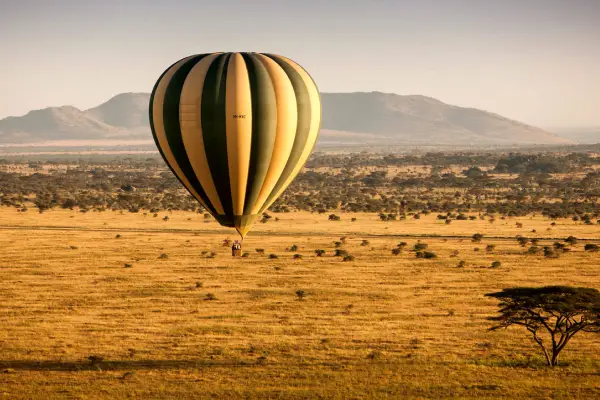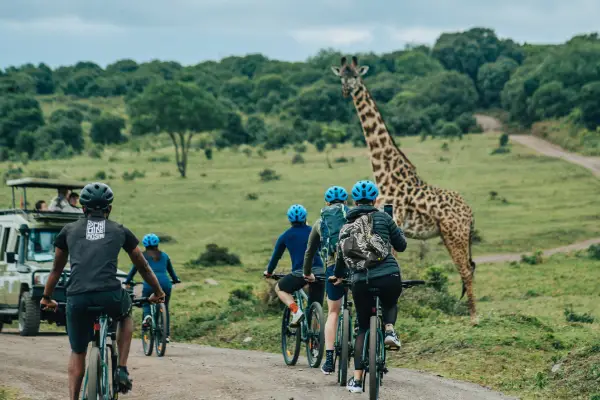100% refundable deposits
100% refundable deposits
The Best Time to Visit Tanzania is from late June to October during the dry season. Also, the country experiences two rainy seasons, with heavier rains from April to May and lighter, brief showers around November to December.
This shows that each season in Tanzania has so many cool things to see and do. Hence, the perfect time for a Tanzania Travel depends on what you want to see and do.
But, remember, Tanzania’s charm shines year-round, so whenever you come, you’re in for a treat!
The months of June to October and December to February truly are the best time to explore Tanzania! We call them 'Excellent' for a reason that is explained in detail below:
From June to October, expect nothing less than a blockbuster Tanzania Safari experience. The days are bright and sunny and filled with abundant wildlife and the spectacular Serengeti wildebeest migration. Animals often gather around waterholes, making them easier to spot on the Tanzania Safari Tour.
Visiting Tanzania from December to February is like winning the safari lottery. With lush landscapes and cute baby animals all around, this is just another Best Time to Visit Tanzania.
Also, the weather remains pleasant, making it ideal for game drives and spotting predators in action, especially during the calving season in January and February.
Don't overlook March, April, May, and November. If you're a fan of rich, green environments, love bird watching, or enjoy the tranquillity of having the parks almost to yourself, these months are hidden treasures. Sure, you might encounter some rain, but the beauty it brings is worth it!
During March, the start of the rains brings excellent bird-watching opportunities and fewer tourists, which means more space and privacy for you.
During April and May, the heavier rains can make some roads tricky, they also create stunning scenery and quieter parks. You’ll find better rates during these months, too.
November is Known for short rains which refresh the landscape with blooming flowers and lush forests, still offering good wildlife viewing, particularly in the northern parks.
Plan your trip around Tanzania's remarkable events, like the breathtaking wildebeest migration, for a truly personalized and spectacular encounter with nature.
January and February are phenomenal months to visit the southern Serengeti to witness thousands of wildebeest births, which attract a plethora of predators and kick off the annual migration cycle.
The daring river crossings by the migration herds occur around July to September and are considered peak Tanzania safari highlights.
This is when Tanzania sees the highest influx of tourists. The weather is ideal for safaris, and the wildlife viewing is at its peak. However, this popularity comes with higher costs and more crowded destinations.
Marked by the heaviest rains, this season offers solitude and the beauty of the rains. Some roads may be less accessible, but the experience of having the parks almost to yourself is worth it.
No matter when you choose to visit, Tanzania offers a year-round spectacle of wildlife, landscapes, and cultural experiences. Each season has its charms and offers different opportunities for visitors.
Want to explore the Best Time of Year to Travel to Tanzania? Get in touch with us to tailor your perfect Tanzanian adventure, whether you're looking for the thrill of the safari or the tranquillity of nature's off-peak beauty. Let’s plan a journey that you'll remember for a lifetime!

All itinerary activities with a local, certified guide

We provide Kailas X3 III alpine tents with vestibules

All nutritious meals while on the trek.

To and from the airport and everything in between

All permit fees and taxes

Solo-friendly by nature, join our small groups



 25°C
25°C
 45MM
45MM
January is a lush and vibrant time in the Serengeti, marking the peak of the calving season. The southern plains come alive with newborn wildebeests and zebras, offering a spectacular wildlife experience. The weather is warm with occasional showers, creating a green and flourishing landscape. This period is ideal for observing young animals and their interactions with predators, all while enjoying a relatively quiet park with fewer tourists.
 25°C
25°C
 45MM
45MM
February continues the calving season with a high concentration of newborns across the southern Serengeti. The lush vegetation supports large herds of wildebeest and zebra, and predator activity remains high, making it an exciting time for wildlife viewing. The weather remains warm with occasional rains, and the park is still less crowded, providing excellent opportunities for intimate wildlife experiences.
 25°C
25°C
 45MM
45MM
By March, the calving season begins to wind down, and the herds start moving northward. The landscape remains green and vibrant due to ongoing rains, but the vegetation starts to thicken, which can make wildlife spotting more challenging. However, the park’s reduced number of visitors means a more serene safari experience, and the start of the migration northward offers exciting prospects for observing the moving herds.
 25°C
25°C
 45MM
45MM
April is characterized by heavy rains, making it one of the wettest months in the Serengeti. The landscape transforms into a lush paradise, but the roads can become muddy and challenging to navigate. Wildlife viewing can be more difficult due to dense vegetation and wet conditions, but the park’s reduced tourist numbers offer a quieter experience and a unique opportunity to see the park in its most verdant state.
 25°C
25°C
 45MM
45MM
May continues with the long rains, maintaining the park’s lush, green appearance. The increased vegetation can obscure wildlife, making sightings more difficult. However, this is a less crowded time, providing a peaceful safari experience. As the migration herds start moving north, there are opportunities to witness the beginnings of the migration, offering a quieter but still engaging wildlife experience.
 25°C
25°C
 45MM
45MM
June marks the beginning of the Avg Temperature, with warm, pleasant weather and minimal rainfall. The landscape starts to dry out, and wildlife concentrations increase around water sources, making it easier to spot animals. The Great Migration typically begins its journey northward, and the park’s clearer conditions provide excellent opportunities for viewing river crossings and large gatherings of wildlife.
 25°C
25°C
 45MM
45MM
July is one of the prime months to visit the Serengeti, as the Avg Temperature is in full swing. The Great Migration reaches the northern Serengeti, where dramatic river crossings occur. The dry conditions ensure clear visibility and easier access to wildlife, though it is also the height of the tourist season. The warm weather and high concentrations of wildlife make for an unforgettable safari experience.
 25°C
25°C
 45MM
45MM
August continues with excellent conditions for wildlife viewing as the Great Migration remains in the northern Serengeti. The dry, warm weather makes for clear skies and easy access to the park’s various wildlife hotspots. This is an ideal time for witnessing the spectacular river crossings and observing large predator populations, though it can be quite busy with tourists.
 25°C
25°C
 45MM
45MM
In September, the Avg Temperature persists, providing excellent conditions for game viewing. The Great Migration herds are still moving south, and wildlife remains concentrated around water sources. The dry weather and open landscapes make it easier to spot animals, and the crowds start to thin out slightly, offering a more relaxed safari experience compared to peak months.
 25°C
25°C
 45MM
45MM
October marks the transition from the Avg Temperature to the short rains. The Great Migration herds continue their southward movement, and wildlife is concentrated around remaining waterholes. The landscape begins to show signs of green as the rains approach, and the park sees fewer tourists, making for a more tranquil and enjoyable safari experience.
 25°C
25°C
 45MM
45MM
November brings the start of the short rains, with occasional showers and a rapidly greening landscape. The migration herds continue moving south, and the park’s transformation into a lush environment offers beautiful scenery. The reduced number of visitors and vibrant landscape provide a serene and picturesque safari experience.
 25°C
25°C
 45MM
45MM
December features ongoing short rains, which further enhance the park’s lush and green appearance. The calving season begins in the southern Serengeti, with herds returning and newborn animals becoming more common. The warm weather and vibrant environment, combined with fewer tourists, create an ideal setting for observing new life and enjoying a peaceful safari.

Talk to Us. Our Experts are just a Click Away!












I hiked Killimanjaro with a local company called Ascend Tanzania. I could not recommend a company more highly.






I had no idea what I was signing up for when I decided, without any prior experience of a trek of this calibre






Climbing Kilimanjaro was one of my greatest mountain experience so far.






Ascend is a top-notch Kilimanjaro tour guide company that I would highly recommend






Ascend tanzania is an affordable company run by the most efficient local people!
"Excellent Company To Climb With"
I booked my Kilimanjaro climb (6 Day Machame route) with Ascend Tanzania because I was travelling solo and on a budget
Read Reviews